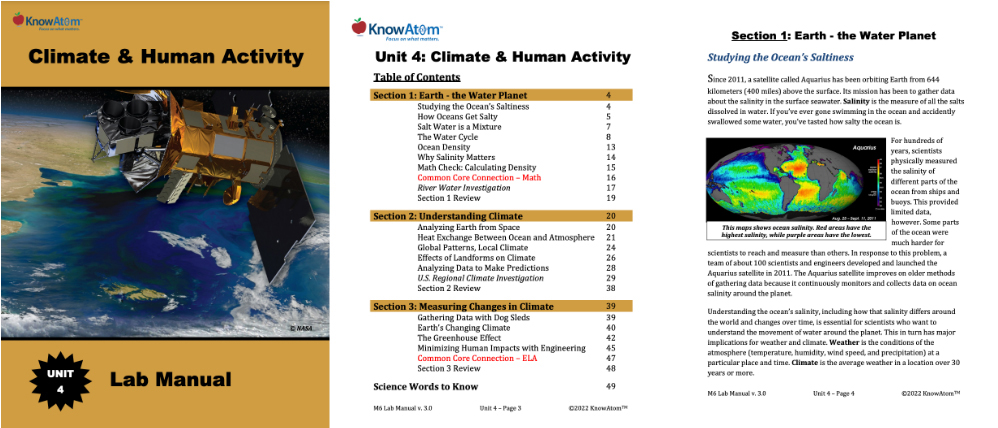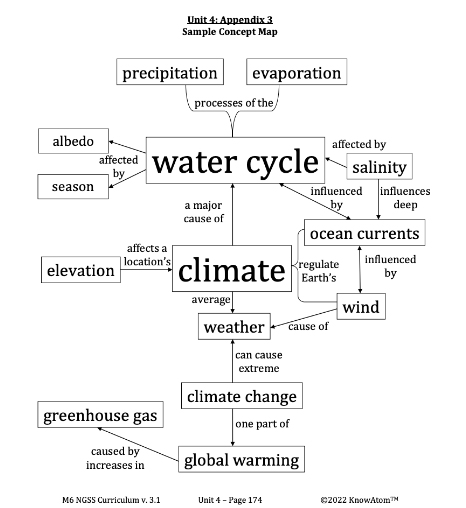Earth’s Changing Climate
Earth’s climate has been changing for millions of years. There are complex variables that influence the climate at any given time. It depends on how much solar radiation is reflected back out to space and how much is absorbed.
If Earth’s climate cools, more snow and ice will form. This will cause more solar radiation to be reflected back out to space. This will make the climate even cooler. When the planet begins to warm, snow and ice will melt. This will expose darker-colored surfaces and ocean. As a result, less solar energy will be reflected out to space. This causes the warming to increase. These are called feedback loops. A feedback loop is a change in the climate that causes an impact that changes the climate further.
This feedback loop is one reason scientists are particularly interested in changes in the Arctic sea ice. Sea ice has a bright, reflective surface, which means it has a high albedo. As a result, 80 percent of the sun’s energy is reflected back into space. As the sea ice melts in the summer, the ocean absorbs 90 percent of the sun’s energy. This causes oceans to heat up, which causes temperatures to rise even more.
When sea ice melts, it also affects ocean salinity because it provides an input of fresh water into the ocean. This affects global ocean currents, making it harder for warm water from the equator to move north, which in turn affects regional climates.
Melting sea ice also affects heat transfer around the Arctic. During the winter, the atmosphere in the Arctic is very cold, while the ocean is warmer because of the ocean’s heat capacity. Sea ice separates the atmosphere from the ocean, preventing heat transfer from occurring. However, when sea ice is thin or fragmented, heat can escape from the ocean. This causes the atmosphere to warm, which in turn affects the global movement of air currents.
Climate change is a global phenomenon, but it has very local impacts because of its impact on weather systems around the planet. For example, thousands of miles away from the Arctic sits the Maldives, a country made up of more than 1,100 islands west of India in the Indian Ocean. The Maldives is the world’s lowest-lying country, and therefore at risk of rising sea levels. Rising sea levels are an effect of climate change, and a sea level rise of just 0.9 meters (three feet) would cover the Maldives and make it impossible for people to continue living there. Rising sea levels are a result of both the expansion of water with heat and melting sea ice and glaciers.
The leader of the Maldives has turned to engineering solutions to try to reduce the impact of climate change on his country. Remember that engineers use scientific knowledge to design technologies that solve problems. The first engineering solution tried by the Maldives was a seawall that surrounds the country’s capital to keep the rising ocean from flooding the land.
Minimizing Human Impacts with Engineering
Other engineering solutions seek to minimize human effects on the environment. For example, many scientists think that Earth’s increasing temperature will have a dramatic effect on the water cycle. Data show that the amount, frequency, and intensity of precipitation are changing around the planet. Many climate models show that precipitation will increase at high latitudes and decrease at lower latitudes. This means that many locations that are used to large amounts of precipitation may experience more drought. A drought is a period of time when rainfall is less than expected. This dry spell can last for a few weeks, months, or years.
In response, some local communities have turned to different solutions for conserving water. One example is rainwater harvesting, which involves capturing and storing rainwater. People can then use that stored water for future uses, including irrigation, washing, and flushing toilets. With proper filtration, it can even be turned into drinking water. Filtration is the process of separating solid matter from a fluid by having the fluid pass through the pores of another substance, called a filter.
Picture a coffee pot. Hot water is poured into the pot, where it mixes with coffee grounds. A coffee filter then traps the coffee grounds and allows liquid coffee to flow through. Coffee filters are semi-permeable (pronounced sem-eepuhr-mee-uh-buhl). This means that these materials have pores that are large enough for some substances such as water molecules to travel through, but the pores are small enough that coffee grounds cannot move through them and so are trapped in the filter. Water filtration works in the same way. Engineers use different kinds of material to filter out contaminants as water moves through them.
People have been harvesting rainwater for thousands of years, but it is becoming more popular today in areas that are suffering from years-long drought. For example, in the southwest part of the United States, local communities are encouraging everyone to harvest rainwater.
There are several benefits to rainwater harvesting. It can reduce the amount of water needed to draw from public drinking sources such as reservoirs. It can also help to decrease flooding by reducing stormwater runoff.
There are also some drawbacks that engineers need to consider. If too much water is collected through rainwater harvesting, there will be less water to collect in natural reservoirs, which could further impact the water cycle. There are also design challenges to any rainwater harvesting system. For example, any system needs to allow rainwater to enter, but somehow also prevent evaporation.








